Shortly after I rescued three semi-feral horses from slaughter, and put them in with my Andalusian mare, I collected stool samples and sent them off to the vet’s lab for Fecal Egg Count (FEC) testing. Two of my new horses – Montaro and Audelina – had FECs of over 200 eggs per gram. Montaro’s was 300 and Audelina’s was a whopping great 2,725 eggs/gram.
Now, while the BEST de-worming program is good pasture and manure management, since these horses had never been wormed, they were not at risk for having developed resistance and so this was a chance to get them clear and hopefully never have to worm again – or at least very infrequently.
My vet Ellen recommended I give Montaro the regular 25 g dose of Panacur (fenbendazole) and give Audelina the Panacur Power Pack (one 57 g dose each day for 5 days). The purpose of the mega-dose, every day for 5 days, is that it causes the encysted worms to break open and be released into the gut for excretion.
Now, everyone who’s wormed a horse knows that horses detest both the smell and taste of chemical de-wormers. So how the heck was I going to get a semi-feral, 1,800 lb Belgian to ingest FIVE doses in one week??
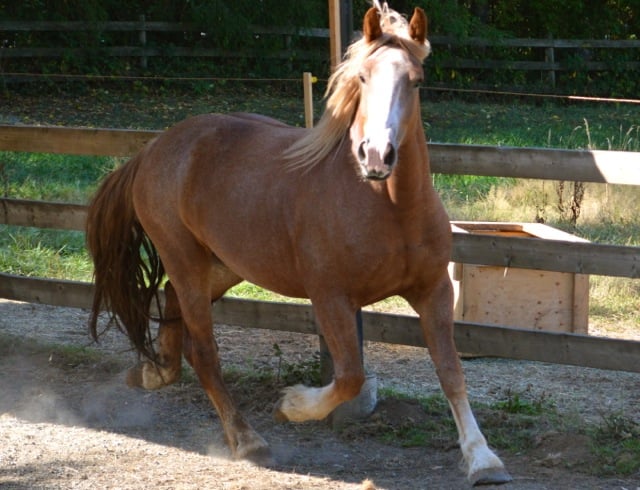
Well, I figured, there was only one way: If it was her choice to take the meds. So how could I explain to her why ingesting this wormer would be a good idea for her, and at the same time help her by making it as easy and as positive an experience as possible?
First, I remembered a trick my equine chiropractor taught me. She doesn’t just give her horses worming syringes, but rather, she alternates with syringes of apple or peach juice. That way the horse doesn’t categorize all syringes as ‘bad’ but instead stays open to possibilities when they see the syringe coming, as who knows, it may be yummy peach juice! I had also read about using applesauce in the syringe, and as I had some of that on hand, that’s what I used.
So I’m going to take you step-by-step through the process I used with Audelina, but know that I used the same process with Montaro as well. And also, know that every step of this process was done out in the pasture, with all the horses unhaltered, and no rope or other method of restraint. They were fully free to walk or run far away at any time.
Making the Syringe a Positive Experience
I started by filling a syringe with applesauce. I let Audelina sniff it (I’m going to demo the steps here with Zorra and a few of the other horses for you):
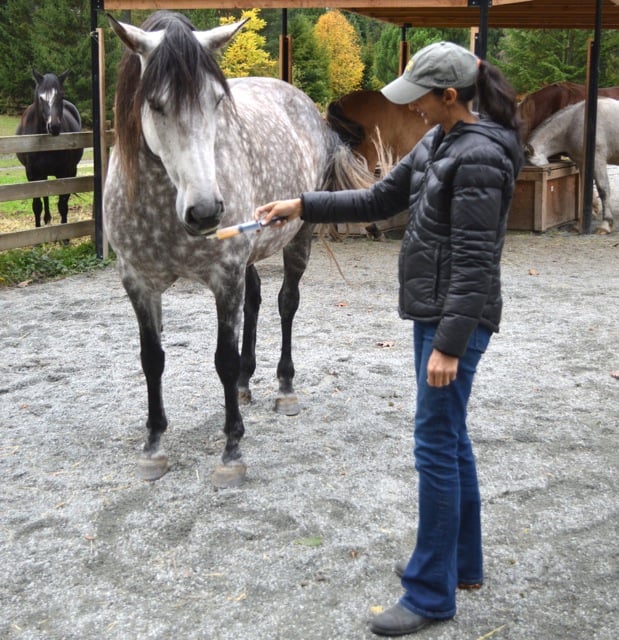
Then squirted some onto my hand and let her eat/lick it off my palm:
Then she allowed the syringe at the tip of her lips, so I squirted some there:
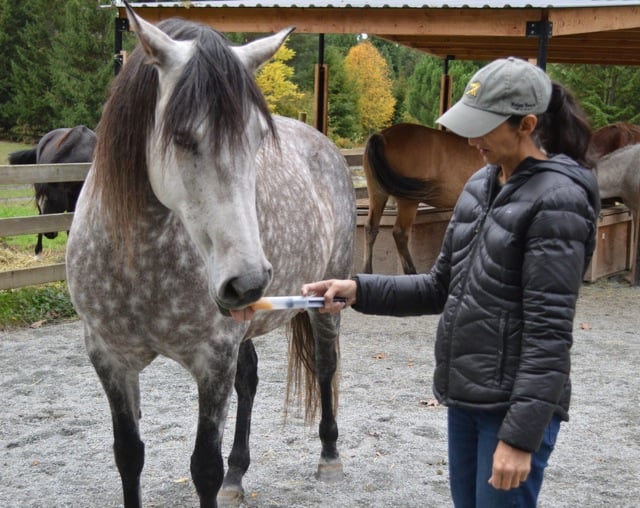
A lot fell on the ground, but enough went in her mouth for her to get a taste. By that time, the syringe was empty, so that was enough for that day.
The next day, I again filled the syringe with applesauce and let her sniff it. She then opened her mouth to grasp the syringe between her teeth and I squirted some in. She ate it, then came in to get more. This time I tried to maneuver the syringe more towards my target location – the furthest side of her lips, over her tongue – but I also wasn’t too worried about it as I knew this process would take some time and the most important thing was to keep it a positive experience.
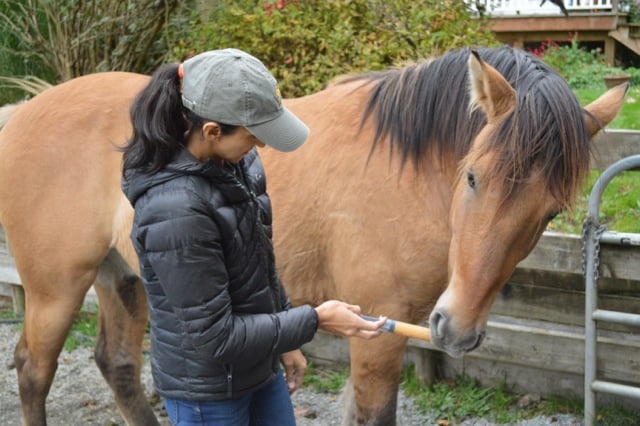
The next day, same thing. But then I also went back and refilled the syringe and put more focus into getting the syringe into the proper position before squirting. Remember, Aude is unhaltered and unrestrained throughout every step of this process.
In hindsight, and if I were to do this again, at this stage I would also have a couple of carrot pieces in my pocket. And as soon as she ate/swallowed the applesauce, I would give her a carrot chaser. Double delight! Oh the deliciousness of syringes and so much to look forward to!
A couple of days went by and I went back out with a syringe of applesauce again. This time I was able to easily place it in the correct position and squirt the entire contents to the back of her mouth, over her tongue.
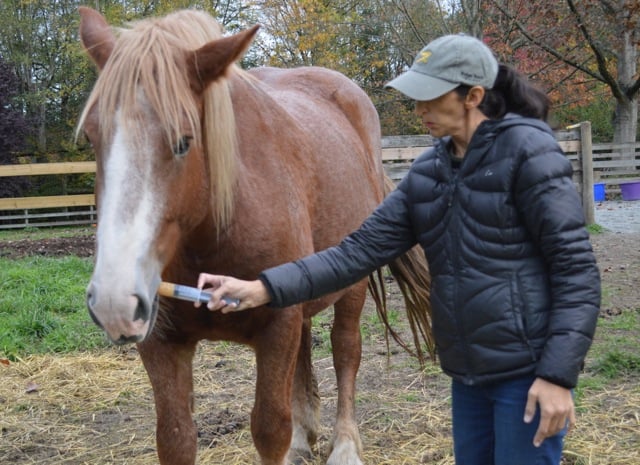
Now for the Worming Syringe!
A couple of days later, I went out with the first huge syringe of Panacur (Fenbendazole). To be honest, I really didn’t have any hope of her swallowing much once she got a taste of it. But of course, I had to try.
I showed Aude the wormer syringe and I explained to her how it works and asked if she felt she needed it, and if she wanted to kill the worms and get them out of her body, or if they were fine and she just wanted to leave them be – if her immune system was doing a good enough job on it’s own?
I said, “This wormer doesn’t taste nice and it’s got a gloppy texture. But if you can swallow it, it will go into your belly and kill the worms and eggs in there, so you can poop them out and get them out of your body. If you were in the wild, on thousands of acres, you would be able to find plants and tree bark to do this job for you. But here, this is the only option I have for you. So I’m leaving it up to your body wisdom, because you know your body best. Do you want help killing the worms, or is your body just fine and can handle the worm burden on it’s own?”
I think it’s important to understand that I really was fine for her to say No. And I would have asked again a few times, but I was fully prepared to have her refuse it. Because although her FEC (fecal egg count) was very high, she showed no signs of disease.
Now yes, there’s a chance that she would show no signs of disease or distress until the worm population was so large it caused a blockage in her intestine and she colicked and required surgery to manually remove the glut of worms. That certainly is a risk factor. But for horses in low stress situations, kept on plenty of open pasture where they can move and roll normally (i.e. not stabled horses, not performance/sport horses), I think the risk is fairly low and Dr. Martin Nielsen’s 35 years of research confirms this.
So, understanding that my energy/agenda was not set in stone that Audelina must take this wormer, or else! But that I was still very much in the energy/position of allowing her body wisdom to make the right choice for her body, at that time. I showed her the uncapped syringe of Panacur and let her sniff it.
Note: If you have a horse who is highly resistant to syringes you can also dip the tip of the syringe in molasses to make it more acceptable to the horse.
She took the Panacur syringe between her teeth and I wiggled it into a better (but still not ideal) position and then depressed the plunger. As the taste hit her mouth she went BLECH!! And tossed her head and spat about half of it out all over my pants, my boots, and the ground. I started laughing and saying, “Aude, my pants!” And then I had an idea, ran back into the barn and grabbed a carrot to help her clear the taste out of her mouth. I broke the carrot up into 3 pieces and fed it to her. She took it eagerly and enjoyed it.
I then wiped up my pants and boots and got her vitamin/mineral/herb feed for her to gobble up. So again, another positive stimulus right on the heels of the yucky wormer.
The Next Day
Well, I didn’t have much hope that she would want the 2nd dose of wormer right after spitting out half of the 1st dose, but hey, no harm in trying right? This time though, I broke a carrot up into 3 pieces and stuffed them in my pocket, ready to go.
I told her again about how the wormer could help her body and asked if she wanted/needed its help. I also told her I had the carrots ready this time to help her swallow it. I let her sniff the Panacur syringe as I was explaining this to her. She again took the syringe between her teeth and I said, “Let me get it in the right spot so you can swallow it easier and not taste it so much” as I slipped it to the back of her mouth, over her tongue, with the squirt hole angled towards her ears.
This is where it really helped for me to have had so much practice with the applesauce syringes. My body had also become fluent with handling, placing and depressing the syringe, so I could do it easily, quickly and with no stress vibes from my body! I also had learned how to position and depress the syringe without hanging onto her head, or using the bridge of her nose as leverage.
It’s also easier if you hold the syringe in this position – with the plunger in the palm of your hand, rather than on your thumb. It may feel easier to depress the plunger when it’s on your thumb, but that actually makes the entire syringe more wiggly and unstable. So when the horse is exploring it, or biting it, it can be knocked sideways easily. This position takes a bit of getting used to, but it is much more stable, so you can be more relaxed when positioning it in the horse’s mouth:
I got the idea for the syringe hand position from this video:
Carrot Chasers
Immediately after depressing the syringe and having the full dose shoot to the back of Audelina’s mouth, I gently cupped the top of her lip and underside of her bottom lip for a couple seconds, with just a little pressure encouraging her to close her mouth, while I said, “Remember to keep your lips closed so you can swallow and it doesn’t spit out.” Then I whipped out the first piece of carrot and fed it to her while she was still trying to swallow the wormer.
I think these ‘carrot chasers’ make all the difference – both in countering the taste and helping the horse to clear her mouth and swallow. As soon as she finished the first piece, I gave her the second piece of carrot. By that time, she had swallowed/eaten all the worming paste. I praised her, gave her love scratches, and went to get her vitamin feed – which she loves as much as carrots.
Note: I had already checked with my vet whether it was okay to follow the wormer with food, or whether the de-wormer needed to be given on an empty stomach to work properly. She had confirmed that the medication does not require an empty stomach and I could follow it immediately with food, no problem.
Following The Horse’s Body Wisdom
The next day, I proceeded in exactly the same way – keeping in mind that I was leaving dosage and frequency entirely up to her body wisdom. Maybe she didn’t need 5 doses? Maybe only 2 or 3 were sufficient? It continued to be her choice.
Audelina continued to take the wormer paste willingly, unhaltered and unrestrained, immediately followed by the carrot chasers.
After the 4th dose, I could tell that she felt like crap, her belly was bloated and she was in pain. She was also eating less hay than normal. I sat down next to her and explained that she was now at the stage where the encysted eggs were being broken open and released into her gut and that’s why she was in pain and discomfort.
I told her I thought it would be good if she walked as much as possible, maybe try trotting and see how that feels. Then I gave her a belly rub and the Colic Pump massage to encourage intestinal peristalsis. I let my hands feel for how and where her belly wanted to be touched. And watched her for any signs of discomfort. Of course, she remained unhaltered and free to walk away at any time. Then I flowed green and white prana in through the top of my head and out the palms of my hands into her belly – to help with clearing, detox and healing.

I offered Audelina the 5th dose, but not surprisingly, she just turned her head away, looking queasy and miserable. I gave her just the carrots instead, and when I brought out her vitamin/herb feed, I gave her extra echinacea, astragalus and goldenseal to help her immune system, as it was now working extra hard to cope with the worm expulsion and the drug toxicity.
I didn’t get out the barn the next day, but by the following day, her belly had slimmed back down and she was back to her usual happy, energetic self. So I offered her the 5th dose and much to my surprise, she took it!! Followed immediately with carrot chasers and then her vitamin/herb feed.
Magnesium Flush & Probiotics to Complete the Process
Two days later, I began adding magnesium to her feed (to help her flush her intestines and really get a good clear out), starting at 5,000 mg/day and increasing to bowel tolerance. Along with a double dose of Equiflora probiotics. I supplemented with the extra magnesium and probiotics for the next two weeks.
Remember, opportunistic organisms love a cleared-out gut! So don’t leave the gut open for re-infection after after killing pathogens, but rather, immediately flood it with beneficial bacteria and establish a good gut flora as quickly as possible.
P.S. The same advice applies to humans following antibiotic usage or a parasitic cleanse 😉
During this de-worming period, Audelina passed 2 adult worms in her stool, about 4″ long. The worm eggs are microscopic, so can’t be seen with the naked eye. But I will have her feces tested again after the 2-week shedding period is over and then again at 10 weeks post-worming. That will then tell us how successful the de-worming was and whether her Fecal Egg Count has decreased.
After the 2-week shedding period, I will also have her field cleared of manure, so the massive amount of worm eggs she is shedding will not be re-ingested by her or the other horses! We have to remember that chemical de-worming is decreasingly effective due to parasites evolving (yes, they’re intelligent!) and developing resistance, so the real KEY to keeping the worm burden normal/manageable for our horses is via manure management; clearing and composting manure.
What About Montaro?
And Montaro? Well, Montaro had previously been wormed with Ivermectin at his interim home after the auction – so he (like my 10-year-old mare Zorra) was very resistant to even sniffing the syringe filled with applesauce. His mind had already made the association that all syringes were to be avoided.
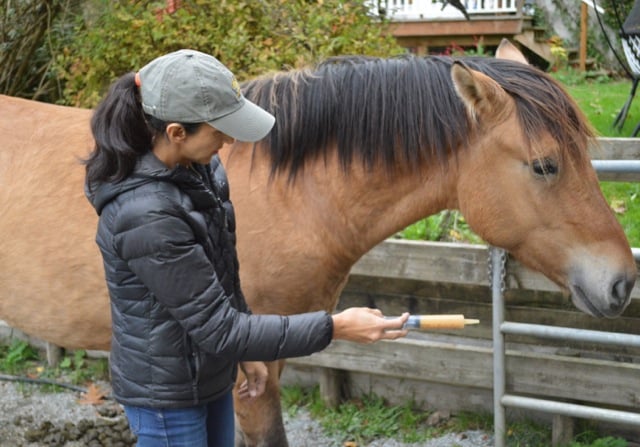
However, after seeing me syringe some onto my hand, then sniffing and licking my hand a few times, he began to show interest in the syringe:
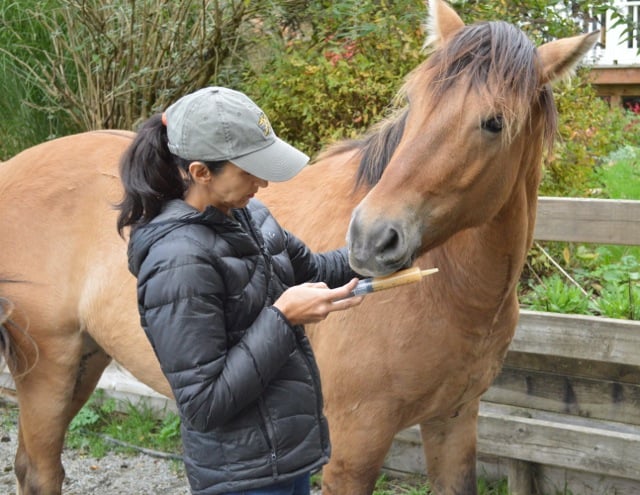
As I said, I followed the same process I outlined above for Audelina, and when I brought out the Panacur syringe, he too took his full dose. But he hated the taste so much, he just walked away in disgust. I had to follow him and wait a few minutes until he was willing to eat the carrots. But he did not try to spit the wormer out, he swallowed it all, and then ate the carrots when he was finished being so pissed off about it!
I offered the applesauce syringe to baby Jax (18 months old) but he does not even like apples or carrots, so he was not interested in it at all. As his FEC was 60, I was not bothered too much about de-worming him. I let him sniff the Panacur syringe, but he walked away and wanted nothing to do with it. Fair enough. That was his choice. But I will test his stool again at 10 weeks and see if the count is still low.
The other interesting thing about de-worming this way, with all the horses free and unhaltered is that they become really curious about what’s going on. And they quickly realize that good things are coming out of the syringe!
Here’s another auction horse – Farrah, recently arrived, belonging to my friend – who had very little positive contact with humans previously. But she really wanted to know what was in the syringe!:
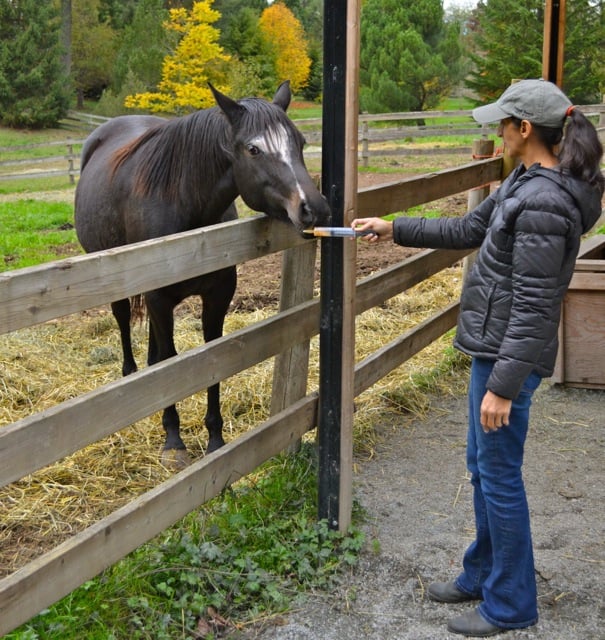
And then quickly realized that the syringe contained something yummy – something positive that she would like to have again:
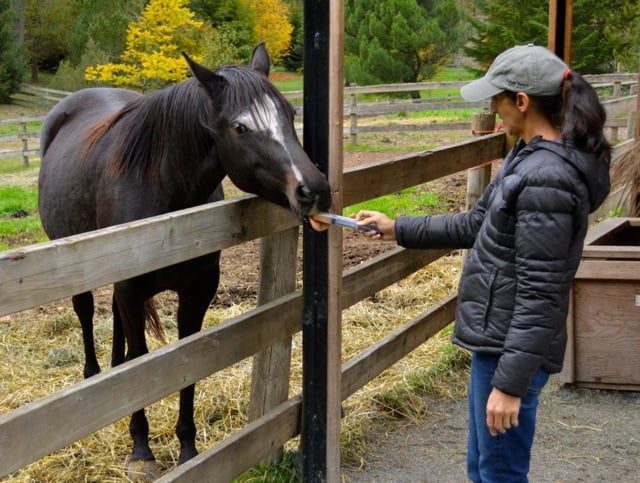
Keep in mind, that if your horse already hates wormers and syringes, that this process is going to take even longer. My 10-year-old mare Zorra had been wormed regularly her whole life and she wouldn’t even investigate the applesauce syringe until I’d offered it to her about 5 or 6 times. Even after squirting it on my hand, she wouldn’t take it from the syringe until the 5th exposure.
So be prepared to have a lot of patience and gradually un-do the negative programming if needed.
Then, after administering the chemical wormer, go out there again after a few days with another applesauce syringe, so you layer a positive syringe experience over top of the negative one.
Proof of Equine Body Wisdom & Communication
For me, I have been in a state of awe throughout this process. Yes, I know I write about communicating with animals all the time. But at the back of my head, there is always this tiny questioning voice going, “Are you sure you’re not just making this shit up??”
The larger part of me says, “How much proof do you need that this stuff is real and is actually happening?” The intellectual part of me rattles on about quantum physics and the holographic nature of the universe. And the reasonable part of me reasons, “Well, if it didn’t work, you wouldn’t still be doing it after 40 years, now would you?”
But honestly, this process – especially with Audelina taking FIVE mega-doses in one week, of a medication that tastes gross and makes her sick… entirely free and of her own choice… This process is the closest thing to proof I’ve encountered yet. Seriously, I’m in awe; it’s been an amazing experience, and I feel privileged to have been able to play a part in it.
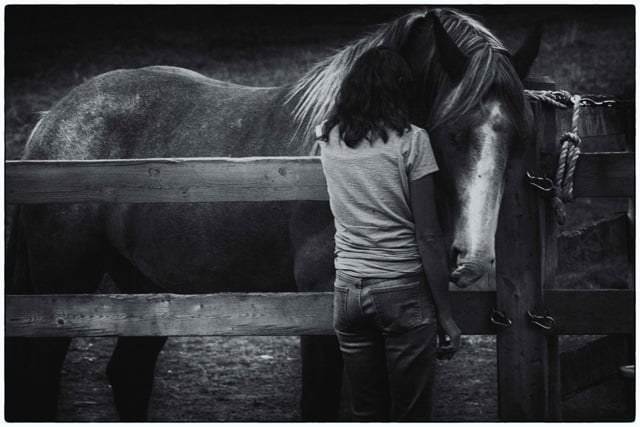

Jini Patel Thompson is a natural health writer and Lazer Tapping instructor. She began riding at age 2 in Kenya, and got her first horse at age 8 in Alberta, and so continues a life-long journey and love affair with these amazing creatures.

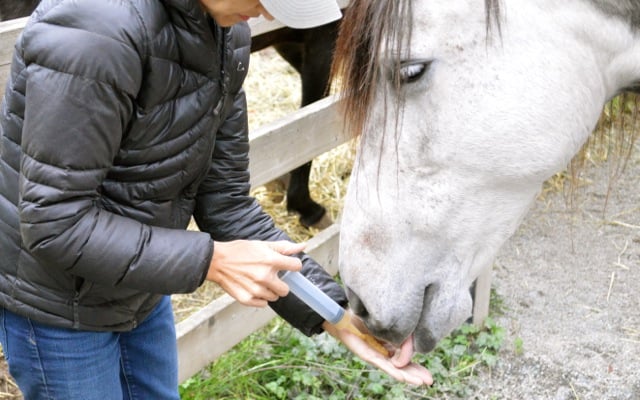

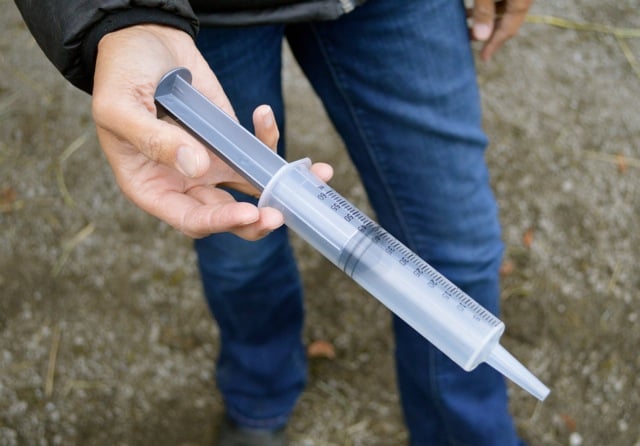
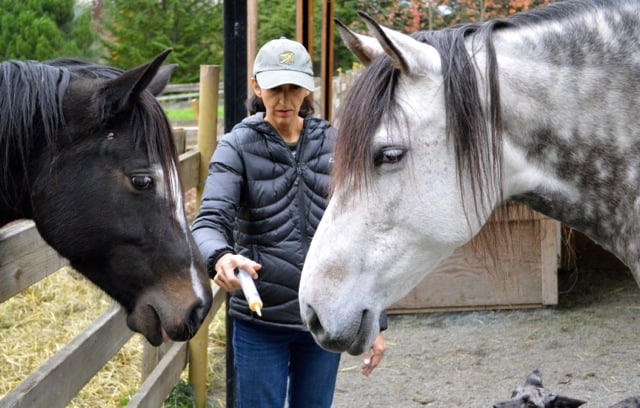







LOVE this! A friend of mine’s stallion, raised from birth, will take his wormer over the stall door without any issues at all. She’s always been loving and gentle with him and he has no reason to fear.
That’s great Liz!
Love your article, thanks. My mare, who won’t even think of eating even her very favourite apples after her rare chemical de-wormings, can’t wait for her organic blackstrap molasses water chaser!
Oh, excellent idea! How do you give her the molasses water chaser? In a bucket, or syringe, or ??
My horse doesn’t want to eat anything after deworming, he would spit out a piece of apple. Until it’s apple tast in the syringe, no problem, but if the taste is nasty he will remember the next time and just turn away. It needs some patients and friendly insisting to make him at least stand still, especially after several days of antibioticcs and medicine against infammation. Injections are not a problem at all though.
Yes, when I had my 2 stallions gelded, they were both totally fine with the injections. I just got them used to it a few days beforehand by pinching the skin on their neck (vet’s advice) every now and then.
I’m wondering if you’ve tried Effective Pet Wellness for worming your horse(s)? My mare went from 974 to 400 FEC using their Horse Clear and Clearacell and now almost 3 mos. later I’m getting ready to put her through a 2nd round adding the Strongyle kit. If interested in the before/after lab result, let me know and I’ll share.
WOW! I just had a look through their site. Here it is for anyone else who wants to check it out:
http://www.effectivepetwellness.com/horse-worms-parasites
I have to say, I really like the ingredient list in the Horse Clear. I do question whether the dosage is high enough to make a difference though… I feel like you’d need to feed at least 1/2 cup per day, but then, would the horse eat that much? Olive leaf, for one, is quite bitter.
And 400 FEC is still a ways above that magical 200 FEC that parasitologist Dr. Martin K. Nielsen reports is the ONLY correlation (below 200 FEC) to actual reduced worm burden that they’ve seen. But please post your total FEC reduction after you’ve done the Strongyle kit and let us know the effects.
I wish they had more info about themselves and also from Dr. Brenda Bishop – is she testing these products in her own practice, what results is she seeing, etc?
Still, like I said, I like their ingredient list and these are definitely worth a try – maybe even at double the recommended dose?
Well, please let us know how it goes and what happens, I’m very interested to hear your end results and fingers crossed as it would be WONDERFUL to have an herbal alternative!!
Hello! Thanks so much for inviting me into this thread! My name is Timothy and I am a Co-Founder at Effective Pet Wellness. Our products have been used in a private clinical setting for about 20 years, and now for the past few years we have been providing them to the public. We experience the highest success rate when working with neurological diseases such as EPM, Lyme, and Bartonella (Shivers). Dr. Brenda Bishop is a world renowned expert on Bartonella, and uses our Bartonella Kit exclusively when treating her clients horses. Her and Dr. Edward Breitschwerdt (who has created the worlds most accurate DNA testing for Bartonella), are in the middle of using our kit in treating Bartonella horses throughout the world and publishing their findings. All of this was spawned after we successfully eliminated the Bartonella infection from the first confirmed Bartonella horse in Australia. The mentioned study above will be finished and published once 10 horses have been treated. As of now, we have eliminated the infection in 100% of the horses (8 so far). Dr. Brenda Bishop offers her self to discuss with any of our clients or potential clients – her phone number is on her website http://www.equineshivers.com
As for strongyles – a very tricky and unique infection. We feel the newest version of our strongyles kit could be the very effective protocol to fully eliminate them that we have been searching for. The above results our client shared in this feed above are NOT acceptable to us. We have found the real issue is with the rapid reproduction of the roundworm, and that is our current focus within this treatment – fully inhibit the egg laying cycle while Horse Clear works its magic.
We would love to offer a discount to anyone who reads this. I have created a special coupon code Listen20 – for 20% off. We would love to have your feedback and work closely to get the results we both want.
We are very close in stabilizing a truly natural way to eliminate this growing epidemic that is becoming more and more antibiotic resistant! Thank you for all the work you and your readers do in service to the Horse. Please contact us with any specific questions. Have a blessed day.
Hi Timothy, Thanks so much for joining the discussion. I had a look at your Strongyles Kit:
http://www.effectivepetwellness.com/equine-strongyles-kit
And I like the ingredient list, frequency and potency of it. My only question is: How do you get a horse to swallow capsules? I’ve found my horses will eat Vitamin E gelcaps just placed in their feed dish, but not regular capsules. Also, I’ll bet these are quite bitter once the horse bites into them. How are you administering these?
And thanks so much for the coupon code!
I ordered the Strongyle kit this past Saturday and am anxious to give it a try. I am very glad there is a natural option to “worming” my Mustang! I put the capsules in Raven’s rice bran/vitamin mineral supplements and she just eats them along with everything else.
We’re looking forward to hearing your results Lisa! Would be SO great to have this as a reliable alternative to the chemical wormers.
Awesome discussion, everyone! I asked Jini to explain her process with Aude so I could try with Mama Molly, and instead we all got this amazing, detailed post (does Jini write any other kind??), and I’m learning so much from the comments too.
All the great info aside, this sentiment really struck a chord with me:
“But at the back of my head, there is always this tiny questioning voice going, “Are you sure you’re not just making this shit up??” The larger part of me says, “How much proof do you need that this stuff is real and is actually happening?” The intellectual part of me rattles on about quantum physics and the holographic nature of the universe. And the reasonable part of me reasons, “Well, if it didn’t work, you wouldn’t still be doing it after 40 years, now would you?” ”
Doubt seems to be a normal part of exploring things that aren’t validated by the culture around us. But then, it was doubt that pushed me into exploring those same dang things! Doubt that what was considered “normal” was the only way. So my only consistent philosophy (and even I fall short on this over and over as I get all jazzed up about the latest thing I’m learning) is – question everything. Make friends with uncertainty. And do what feels most compelling and correct in this moment. Otherwise, someone like me would never get anything done!
Now to tackle the worming process/questioning of the process/learning curve…. Wish me luck!
Yep I agree. Questioning is always good. And uncertainty doesn’t need to stop us from moving forward, trying things, experimenting, etc. My daughter from toddlerhood HATED to make mistakes, or do anything less than perfectly. Knowing this would seriously hinder her progress in life, I set about teaching her a re-frame for her self-judgement. When she switched her belief and M.O. to: “Mistakes are GOOD. It means you’re learning!” Oh her life became so much sweeter and easier.
Ok.. So, I ordered the Strongyle kit, which included Proteka, Horse Clear and Clearacell at the end of October and put my Mustang through the whole routine. All doses taken… I waited 6 days to collect a sample to be sent off to the lab. Prior to starting, her FEC had shot up to 1400 eggs per gram (!!) in just 3 mos. since the last dose of ONLY the Clearacell and Horse Clear. My vet called this morning with the results after the Strongyle kit and the FEC is down to 600 eggs per gram, which is still not low enough.
I am hoping Timothy @ Effective Pet Wellness will see this post and give me a suggestion since I would really prefer not to go the chemical route.
Yes, hopefully he replies – might be more reliable to email him via his website though. Did you see my newest post which talks about a soil bacteria that Dr. Nielsen is developing into a natural de-worming solution? It is 97% successful in pig trials:
https://www.listentoyourhorse.com/clinical-studies-on-diatomaceous-earth-as-a-natural-de-wormer/
I used a similar process with my rabbit, by accident. The first time she had to get meds was because my other rabbit had beat her up in the night (she was a baby) and she had some infected wounds. Luckily, the medicine for that was really sweet and she loved it. When it came time to get her spayed (female rabbits get uterine cancer at the drop of a hat), she liked the syringe so much she would grab it and run off with it before I was done dispensing meds! She’s so funny.
Yep, Mary Poppins was right for animals and humans! ‘Just a spoonful of sugar helps the medicine go down…’
The website for Effective Pet Wellness is no longer working. Do you have another way to contact them, or another company that you are using for a more natural way to worm?
They seem to have gone out of business… I can’t find them anywhere.
The most natural worm control is pasture management and manure management:
https://www.listentoyourhorse.com/worming-horses-naturally-is-it-possible/
Here’s the data on Diatomaceous Earth:
https://www.listentoyourhorse.com/clinical-studies-on-diatomaceous-earth-as-a-natural-de-wormer/
– SEE my last comment underneath this post and the link there to a natural wormer that just may work due to the addition of cayenne and garlic.
And this looks the most promising, but it’s not available yet:
https://www.listentoyourhorse.com/new-natural-wormer-crystal-proteins-from-bacillus-thuringiensis/
I have been using Silver Linings herbs #13 with great results. The dose is given a day or two before the full moon and runs for 10 days. After the last dose wait 7 days before collecting your sample to send to the lab. The epg number varies, but has consistently stayed low using this method.
Oh that’s good to know Lisa. I remember emailing with you in the early days and we were wondering how it would work over the long-term, so good to hear the FEC stayed low!